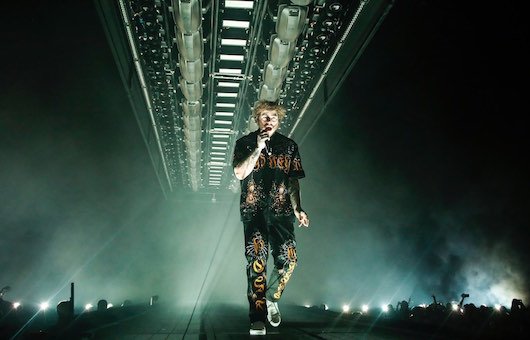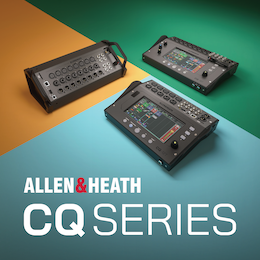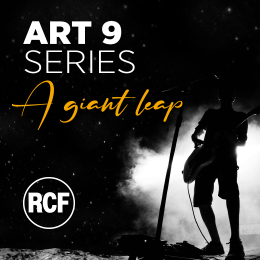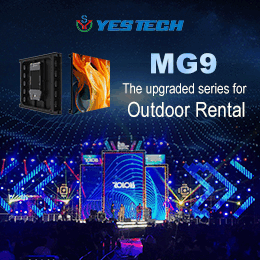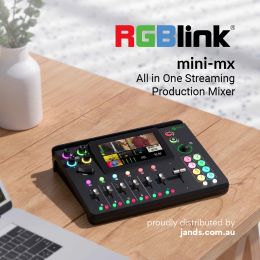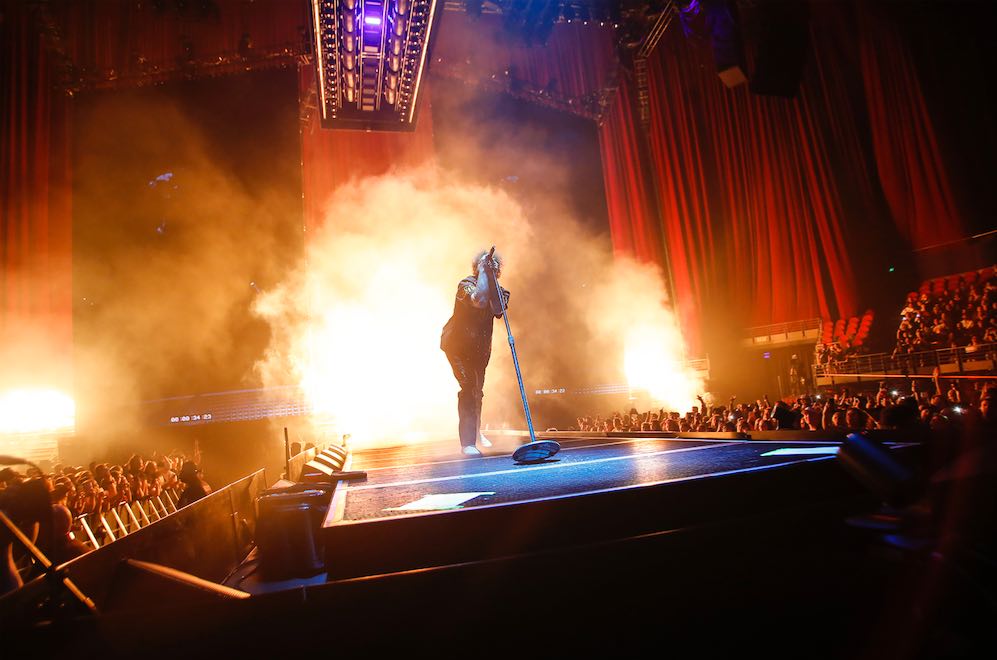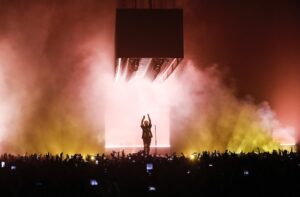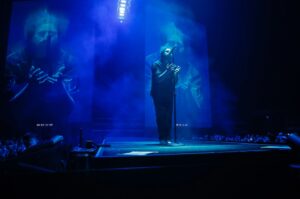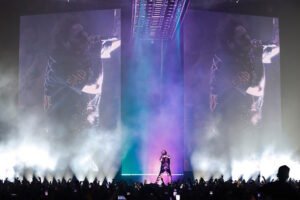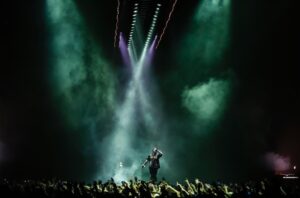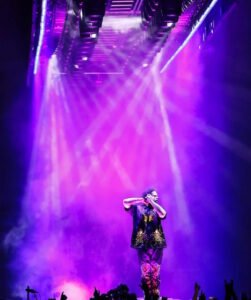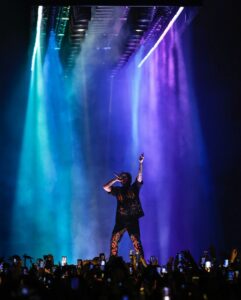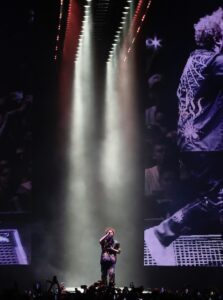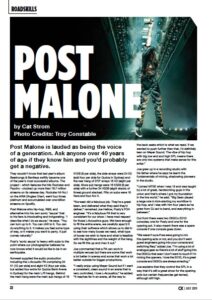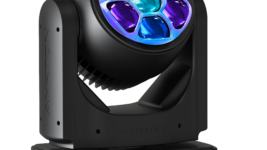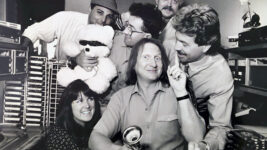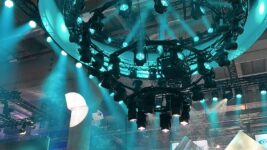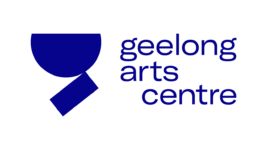Subscribe to CX E-News
ROADSKILLS
Post Malone
by Cat Strom.
Photo Credits: Troy Constable.
Post Malone is lauded as being the voice of a generation. Ask anyone over 40 years of age if they know him and you’d probably get a negative.
They wouldn’t know that last year’s album Beerbongs & Bentleys swiftly became one of the year’s most successful albums. The project – which features the hits Rockstar and Psycho – clocked up more than 78.7 million streams on its release day. Rockstar hit No.1 on the ARIA Singles Chart, went four times platinum and accumulated over one billion streams on Spotify.
Post Malone stirs hip-hop, R&B, and alternative into his own sonic “sauce” that to his fans is intoxicating and invigorating. “I describe what I do as sauce,” he says.
“You can turn up to it. You can chill to it. You can do anything to it. It makes you feel some type of way, or it makes you want to party. It just comes naturally.”
Post’s ‘sonic sauce’ is heavy with subs to the point where our photographer believes he now knows what it would be like to be in an earthquake.
Norwest supplied the audio production including the L-Acoustic PA comprising 24 K1 (12 per side) and eight K2 (four per side, but added four extra for Qudos Bank Arena in Sydney) for the main L/R hangs. Behind the main hang were the main sub hangs of 16 K1SB (8 per side), the side arrays were 24 K2 (add four per side for Qudos in Sydney) and the rear hang of 270° arrays 16 K2 (eight per side). More sub hangs were 16 KS28 (8 per side) with a further 24 KS28 (eight stacks of three) ground stacked. Fills on subs were 16 Kara and four Arc II.
“Norwest did a fabulous job. They’re a great team, and delivered what they said they’d deliver,” remarked Joe Hellow, Posty’s FOH engineer.
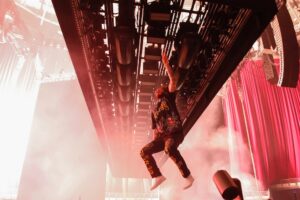 “It’s a fabulous PA that is very consistent for our show. I have mad respect for those L-Acoustics guys. We have enough to fill the entire arena, we carefully spec’d it using their software which allows us to dial in to see how many boxes we need, what type of boxes we wish to have and what is feasible with the sightlines and the weight of the hang. So we fill this up and max it out.”
“It’s a fabulous PA that is very consistent for our show. I have mad respect for those L-Acoustics guys. We have enough to fill the entire arena, we carefully spec’d it using their software which allows us to dial in to see how many boxes we need, what type of boxes we wish to have and what is feasible with the sightlines and the weight of the hang. So we fill this up and max it out.”
Joe commented that a PA can work in multiple venues but there are some that work a lot better in arenas and some that work a lot better outside for bigger productions.
“I really enjoy using Meyer Sound but if I want a consistent, clean sound in an arena that is very controlled, I love L-Acoustics,” he added. “It reaches far in an arena, all the way to the back seats which is what we need. If we wanted to push further than that, I’d definitely lean on Meyer Sound. The vibe of hip hop with big low end and high SPL means there are only two systems that make sense for this artist.”
Joe grew up in a recording studio with his father where he says he learnt the fundamentals of mixing, shadowing pioneers in the studio.
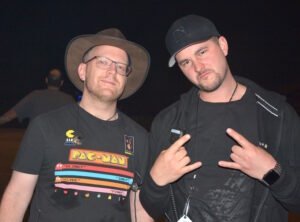
Willie Linton and Joe Hellow
“I joined IATSE when I was 15 and was taught by a lot of great, hardworking guys in the union and that’s where I got my foundation in the live world,” he said.
“Big Sean played a large role in kick-starting my workflow in hip hop, and I was with him four years as he grew from DJ act to band, and everything in between.”
Out front there were two DiGiCo SD10 consoles; one for Posty and one for the opening act. It also meant there was a spare console if one console goes down. “We weren’t sure if we were going to mix the opening acts or not, and you don’t want guest engineers going into your console and switching files,” added Joe.
“I’m using a lot of analogue gear so there’s a lot of stuff going into the DiGiCo that even I don’t want to touch if I’m mixing the openers. I love the SD10, it’s a great console and DiGiCo are always amazing.”
Joe explains that they control the SPL in a way that it’s still a great show for the opening acts but certain frequencies get tamed, although still high. “We don’t want to blast everyone so that they’re frosty by the time Posty goes on! They get a build up to his set which we can control and make sure it sounds nice.”
Having grown up in an analogue studio, Joe says he notices the loss of warmth and headroom with digital gear and so he utilises a fair amount of conversion.
“I’m using Apogee’s Symphony I/O to convert all my digital to analogue and analogue back to digital and the difference is night and day,” he said.
“I really appreciate Apogee for helping me through that and working together on building something that is road-ready and lasts on tour. Some interfaces can’t handle being on the road but this one is meant for it – it has Waves SoundGrid built in so it’s one Ethernet line that goes into the console.
“You really notice the difference.I also use a lot of Neve and API, enough said. Baddest of the bad. Best channel strips in the world.”
Joe utilises the Waves and console onboard effects, having four different reverbs and three delays that change per song. He says that although DiGiCo make a great reverb there are certain things that match Posty’s album for which you need to use use Waves.
“It’s like a rollercoaster of sound waves and emotion filled with impactful, meaningful timings of big hits and it’s a beautiful thing,” elaborated Joe. “With his passion on stage we just try to build our sound around that. He carries the show and we just wrap it around him.”
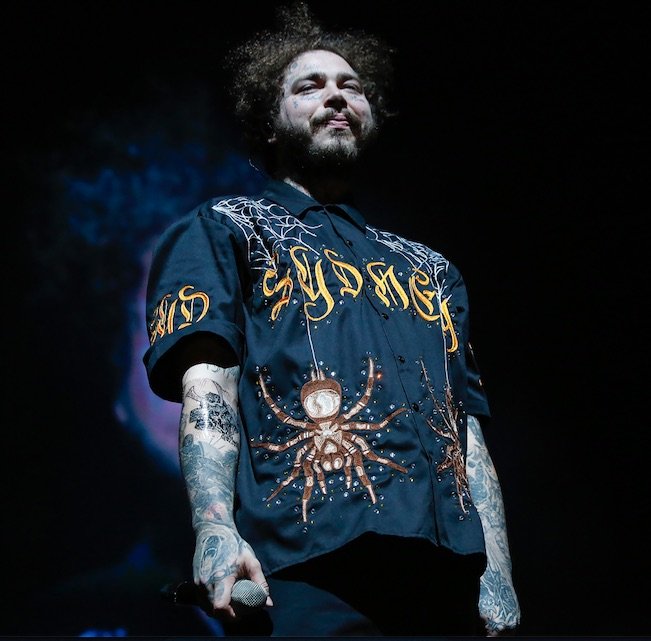 Posty uses a DPA d:facto on a Shure Axient handheld microphone, which Joe loves on his vocal saying he is unique and it sounds amazing.
Posty uses a DPA d:facto on a Shure Axient handheld microphone, which Joe loves on his vocal saying he is unique and it sounds amazing.
“A lot of artists love using a standard Shure 58 but it just doesn’t capture the emotion, the sheen on his voice, the grit – all of that is captured by the DPA and we have the accessibility to manipulate however we need to in order to make it sound proper for the audience.”
As with many acts these days, Posty sings live and the rest is all backing tracks. A lot of time was spent mixing his songs for live performance with Willie Linton in charge of ensuring the music translates from the studio onto the stage. It means that Joe has a whole catalogue of Wav files and they can stem everything out as needed and add or augment with musical director Wow Jones to make it feel live.
For playback Willie uses Linx Aurora interfaces as his main I/O, with Ableton and ProTools.
“Everything starts in ProTools and once I get my mix cool and my arrangements how I want them, I’ll put them in Ableton,” he explained.
“I use a program called Set List that helps me organise all my songs because I actually play back all the songs during the show as well. I have a redundant playback system so if my A computer fails it goes to my B computer. We also use Autotune and other vocal processing live. We have a couple of effects we use and I also set that station up, although I don’t run it.”
“More and more artists are using playback as everything is run on timecode; pyro, lights, video. One of my jobs is to ensure the flow of the show is rock-solid and that every version we have matches because you don’t want a pyro cue going off at the wrong time.
“Sometimes we have up to six different versions of the same song and whatever they need to happen, I have to make happen. They call it the hot seat! Have to ensure it keeps moving.”
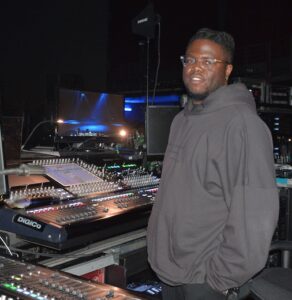
Travon Snipes
Monitor engineer Travon Snipes is the new guy, having only been with the tour for a month inheriting most of the set-up. Currently he has no outboard gear but hopes to sneak some in soon.
“You try not to come into a situation and abruptly change everything but you also want to bring your own character,” he said. “I’ve taken notes on the previous work and kind of put my little spin on it. I’m also using two DiGiCo SD10s and Shure PSM1000 IEMs.
“With Post it’s mainly making sure that he has a great blend of his tracks, making it sound as much as possible like his record. You have a lot of delays going on, just mixing in general trying to make it sound a clean vocal, but not vocal heavy – trying to find a good spot for everything in the mix.”
The stage was very simply a long catwalk, which was flanked by two large LED screens.
A large flown moving structure the same size as the catwalk contained lights, lasers, pyro and smoke. The catwalk was grated and had a large number of lighting units underneath for uplighting.
The flown moving structure or “top box” structure as the crew liked to call it, was jammed with over 400 lighting fixtures. Around its edges were 68 GLP X4 Bar 20 which served to continue the brutalist look of the box as a large solid structure.
“We initially where looking at doing this look with lasers, but the X4 Bar 20 did the job with the fixtures pointing straight down,” said lighting designer Ben Dalgleish.
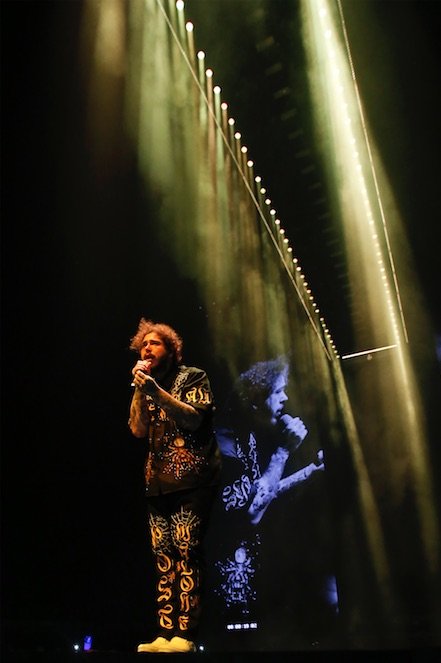 “I tried to design the lights inside the box to be as flexible as possible, as it really is the main eye candy in the show. We have 80 Robe Spikies which can snap from a tight beam to wide wash in seconds. Also the 42 Varilite VL4000 BeamWash, while equally as versatile, are just so bright and big looking they form the majority of the spread-out looks in the show.”
“I tried to design the lights inside the box to be as flexible as possible, as it really is the main eye candy in the show. We have 80 Robe Spikies which can snap from a tight beam to wide wash in seconds. Also the 42 Varilite VL4000 BeamWash, while equally as versatile, are just so bright and big looking they form the majority of the spread-out looks in the show.”
And finally, down the middle of the box were a “spine” of 30 GLP JDC-1 strobes which Ben ran in full pixel mode.
“I wanted to have as many architectural looks as possible in the show, so all the fixtures are grouped as close together in straight lines,” he added. “Using different combinations of beam versus wash, as well as different positions, allowed each song to look very different.”
A total of 64 Claypaky Scenius Unicos started as a workhorse profile spot, but Ben soon discovered that some of the colours they could make really set the tone for a lot of the show. The entire look for the song ‘Too Young’ which starts the show is the Unicos backlighting Post in an incredible deep mint colour, which slowly fades to a rich CTO.
Ben comments that no other discharge moving light he’s seen can come close to making those colours.
“I have these lights running all the way down the audience trusses, and they spend a lot of time lighting the crowd in unique colours,” he said. “We have no traditional blinders in the show, so their brightness and zoom range was well used.”
The rig also had 54 Claypaky Sharpy Washes which were grouped in six pods of nine fixtures each. These were also used for audience lighting as well as a continuation of the shows brutalist look. They rarely move during the show, instead each pod is used as one large light source.
Solaris Flare LR Strobes were both underneath the catwalk, but also behind the video screens in a long line. While they were only used for a few songs, they added a massive amount of depth to the show when they were, and changed the whole look heavily, by giving the screens a monolithic effect.
Smoke has been a large part of the show since Ben started with Post in 2018 and he says that they really try use it as an effect, and not just for the sake of having it look smoky.
Smoke cues are planned and timecoded in specific songs and hours were spent dialing in how the effect is used in relation to not just the lighting, but the Notch effects that run over the IMAG feed as well. There were 24 smoke machines, all with DMX fans, and they were everywhere – in the Top Box, under the catwalk and over the audience.
The majority of the content on the two large LED screens was live IMAG run with Notch effects. Ben says that they are really pushing the envelope with these effects, and the lighting level plays a massive part in how they end up looking.
“We spent a lot of time dialing in each song with front, side and back light, and normally have a few different key light looks per song in order to allow the Notch effects to shine,” he remarked.
“I would describe my lighting as powerful and dynamic. While Post is primarily a Hip Hop/Pop artist, I didn’t want the show to look anything like a normal Hip Hop or Pop show. There are no wild movements with the whole rig.
“Everything is super considered, but programmed to try and make it feel as organic as possible. Just like Post’s music, there are hints of 80s Rock’n’Roll lighting, Heavy Metal, and beat driven EDM style programming.”
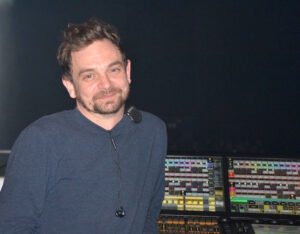
Ben Ward
Finally there were six PRG Bad Boy Spots which were operated by a selection of GroundControl Followspot Systems. Lighting Director on the tour Ben Ward ran the show from behind a trio of networked MA Lighting grandMA2 full size consoles: one for each side of the truss and a third for a FOH view. Having three consoles means Ben doesn’t have to drag a console around every arena while focusing so many fixtures.
CX Magazine – July 2019 Entertainment technology news and issues for Australia and New Zealand – in print and free online www.cxnetwork.com.au
© CX Media
Subscribe
Published monthly since 1991, our famous AV industry magazine is free for download or pay for print. Subscribers also receive CX News, our free weekly email with the latest industry news and jobs.


